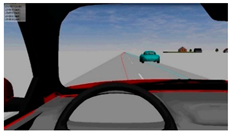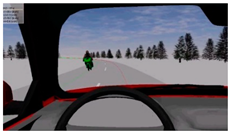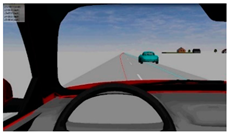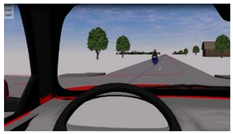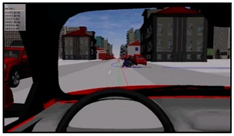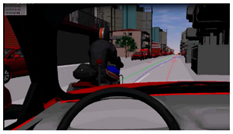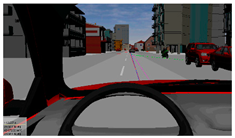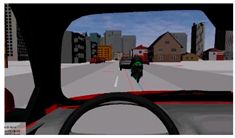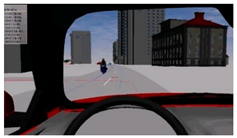Abstract
Research shows that about half of all motorcycle collisions with other vehicles were caused by the accident opponent, typically a passenger car. This study aimed to assess the effect of simulator training on improving car drivers’ perceptibility of motorcycles and thereby addressing this frequent type of motorcycle accident from the perspective of the initiator. For this purpose, a training program with different methods was conducted and tested in a driving simulator with 80 learner drivers aged between 15 and 27 years, assigned to a control group and three training groups: variable priority, equal priority, and equal priority with warning. The conflict scenarios were determined based on an analysis of motorcycle–car accidents. The variable priority training program resulted in better perceptibility of motorcycles as compared to the equal priority training program and equal priority with warning in two out of four test setups, i.e., urban roads with high contrast between motorcycle and the driving environment and on rural roads with a low contrast. Most participants rated each training method in the driving simulator as useful and would recommend it to other learner drivers. These results are important because they show that simulator training has a positive effect on the motorcycle detection performance of learner drivers. The early perception of motorcycles in car drivers is essential for preventing collisions between cars and motorcycles.
1. Introduction
The protection of vulnerable road users is becoming increasingly important due to improvements in active and passive vehicle safety, which is clearly reflected in the accident statistics of the past few decades [1]. In Europe, 14% of fatal injuries in road accidents were related to motorcycle occupants in the year 2017 [2]. In addition, motorcycling is the means of transport for which the number of fatalities decreased the least between 2006 and 2015 [1]. In Austria, fatal injuries due to motorcycle accidents contributed 20.69% (90) to the number of fatal injuries in 2014 (430), and 22.42% in 2013 [3]. Yasin et al. [4] investigated death rates in 2–3-wheelers and found that global mortality increased by a relative ratio of 1.36 over the last decade, which was related to the increased vehicle-to-person ratio and economic inequity. In their study, Ijaz et al. [5] determine the most important risk factors associated with the severity of motorcyclists’ injuries using the logit model with random parameters. The results of the study also show, among other things, that the risk of serious and fatal injuries is increased in accidents where motorcycles collide with cars and trucks. Martins et al. [6] confirm these findings of more severe injuries and outcomes in collision accidents (CA) compared to loss-of-control accidents (LOCAs).
The results of the study by Abrari Vajari et al. [7], analysing the factors affecting the severity of motorcycle accidents at intersections using the multinomial logit model, show that setting certain measures related to t-intersections could reduce the probability of fatal accidents. Some of the additional literature that investigated the causes of motorcycle accidents can be found in [8,9,10,11]. Two main problems were observed: On the one hand, single motorcycle accidents, mostly because of an uncontrollable driving situation, and on the other hand, collisions with another vehicle, representing about 60% of the total. About half of the motorcycle accidents from the latter category were caused by the car driver. The difficulty that drivers have detecting motorcycles due to insufficient contrast, obstructions and the fact that motorcycles are small and fast, was attributed to about 40% of motorcycle accidents caused by a car driver. This research aims to develop preventive training programs for learner drivers and to investigate the role of simulator-based training on the perceptibility of motorcycles. Since perceptibility issues are considered to be responsible for the major portion of severe motorcycle accidents, simulator-based driving education has the potential to increase motorcycle safety.
1.1. State of the Art in Driver Education
The effectiveness of post-license driver training was analyzed in a systematic literature review in [12] and it was concluded that there is no evidence of a positive effect on road safety, which might be a consequence of the training design. In [13], a comprehensive review of driver training was carried out, concluding that driver training did not improve road safety but increased supervision and graduated licensing for novice drivers might help. Isler et al. [14] investigated the effect of handling skill training and concluded that, although driving performance improved, no improvement in hazard perception occurred. Mayhew and Simpson, [15] concluded that empirically based driver training shows more potential for road safety than traditional formal instructions. Schneider et al. [16] conducted a simulator-based training program using micro-scenarios with older drivers and showed that this can increase the frequency of second glances in intersection situations. Haworth et al. [17] suggested adding motorcycle simulator training to the practice of dangerous situations to improve driving skills. However, this education did not directly address the problem of overlooking motorcycles due to failures in perception. In [18], the driving skills of learner drivers with an early training program at the age of 16 was examined. The inclusion of simulator training with a broad range of hazardous situations for education purposes was suggested.
Although research shows that, generally, post-license driver training has little impact on road safety, in [19], hazard perception training was recommended, especially for drivers with fitness-to-drive difficulties. The effectiveness of hazard perception was investigated in multiple studies. According to Wetton et al. [20,21], learner drivers perform worse in hazard perception tests than experienced drivers, and the authors concluded that such training is useful. In [21], different hazard perception tests for driver training were explored and a significant improvement was found. Training effects decayed over time but remained significant. In a study by Rosenbloom et al. [22], drivers with a motorcycle license performed better in hazard perception compared to other drivers. In [23], a video-based hazard perception test showed positive effects on driving performance. Ka et al. [24] used surrogate safety measures (SSMs) in simulator-based training to evaluate accident potential in their study. The risky driving behavior in driving situations that also concern surrounding vehicles could be reduced with simulator- based training and the safety of drivers could be increased by SSMs. Castro et al. [25] explored the effect of proactive listening to training commentaries by experienced drivers. Interestingly, contrary to the objective performance data, the drivers showed no improvements in their self-ratings. Horswill et al. [26] developed an online hazard perception training and found that key behaviors associated with crash risk improved after training. Crundall et al. [27] found that training for hazardous situations in a driving simulator improved driving safety when an instructor provided an explanation during a video-based driver training, and found a positive effect for all types of participants. In [28], a hazard prediction test was performed from the perspective of different road users, and improvements were found in psychometric performance. Borowsky et al. [29] found that hazard perception does not erode over time, which suggests that once learner drivers gain experience in hazard perception, they maintain this ability in future.
From this state-of-the-art, we conclude that training for hazard perception in a driving simulator has substantial potential to improve road safety and that it is especially beneficial for learner drivers.
1.2. Types of Motorcycle Accidents
The analysis of Austrian accidents showed that, between 2012 and 2014, about 35% of all motorcycle accidents were single accidents, followed by accidents at intersections, at a rate of about 27.4%. The third most frequent type of accident was one-way traffic (20.2%), followed by accidents in oncoming traffic (7.4%), other accidents (7.2%), pedestrian accidents (1.6%) and accidents involving stopped vehicles (1.2%) [30]. Between 2015 and 2019, 42% of fatal motorcycle accidents in Austria occurred due to a collision with a passenger car. In 45% of these collisions, the driver of the passenger car was the cause of the accident. In addition, 20% of all fatalities and serious injuries between 2015 and 2019 with a mileage of less than 2%, are motorcyclists. Fatalities per kilometer travelled are 30 times higher for motorcyclists than for drivers of passenger cars [31]. Apart from these general accident statistics, an in-depth analysis of self-reports shows that the most common cause of motorcycles accidents (involving third parties), is that the motorcyclist is overlooked by the car driver (66% of n = 1072, [8]). A total of 14% involved the maintaining of a too-short a safety distance, 15% had other causes and, in 5%, the accident opponent was under the influence of alcohol. The results of this study were consistent with the corresponding statistics of [32] regarding the type of accident. A study of the GDV database [33] describes particularly frequent and typical situations between motorcycles and cars. The selection and preparation of the motorcycle encounter scenarios in the present study were based on the analysis of accidents from different Austrian and European databases [34]. The scenarios identified by Kraut et al. [34], including common accident types, conflict situations and parameters that contributed to the accident, were used for training and tests in the present study. An overview of the scenarios is presented in Section 2.3. The scenarios were developed based on the analysis of accident statistics of real accident data. The objective was to increase the awareness of passenger car drivers by means of appropriate training with the assistance of the scenarios, and thus to reduce the relevant types of accidents. Novice drivers are especially likely to lack the experience to identify critical situations that could lead to a hazard or an accident. Due to the multiple driving subtasks, vehicle drivers must divide their attention accordingly and accomplish multiple control subtasks. The developed scenarios are intended to improve the vehicle driver’s motorcycle perception and hazard recognition, thus promoting their ability to identify critical situations. The early recognition of conflict situations with motorcyclists is intended to improve situational awareness and, thus, the perception of key elements for the control task. The developed conflict situations are based on accident-causing parameters, which should support the car driver to detect attributes that can lead to critical situations. Early detection is the prerequisite for the setting of an appropriate accident-preventing action. The aim is to reduce the number and the severity of car–motorcycle collisions through the early detection of motorcycles by the car driver, to avoid car–motorcycle collisions, and to reduce the number and severity of accidents [34].
1.3. Human Factors Related to Motorcycle Accidents
To reduce the increasing number of motorcycle accidents, it is particularly important to consider the human factor in accident prevention. The perceptibility of motorcycles by drivers is essential for detecting and managing critical conflicts between cars and motorcycles. According to the MAIDS study [35], about 70% of the main causes of accidents in the event of a collision are attributable to the driver of the colliding vehicle overlooking the motorcycle. Therefore, in order to reduce the number of accidents between cars and motorcycles due to the passenger car driver overlooking the motorcycle, it is crucial that drivers of passenger cars learn to recognize motorcycles. Accident statistics show that the perceptibility of a motorcycle by drivers depends, among other things, on the light conditions. For example, in addition to being dazzled by a low sun, changes between light and shade in wooded areas and on mountain roads can lead to poor recognition of motorcycles [36]. In addition to the colour of the motorcycle, both the clothing of the motorcyclist and passenger and the helmet colour contribute to motorcycle perception [37,38].
1.4. Research on Training Methods
The training methods that are relevant for this study focus on improving the ability to perform multiple tasks through better attention control. This is necessary for scanning and detecting motorcycles while driving a car. In aviation, simulator training is widely used for initial and recurrent pilot education [39,40,41]. Research shows that the benefits of simulator training lead to a more accurate estimation of conflict/collision parameters in complex traffic situations [39,40,41].
Wickens et al. [42] assessed the effectiveness of different training methods in developing time-sharing skills or “skills of scanning, bimanual coordination, or task switching that support multitask fluency”. Such time-sharing skills are necessary for controlling a car (e.g., visual scanning, speed control, navigation) or playing a musical instrument with both hands concomitantly. The research shows that the opportunity to practice time-sharing skills, as compared to practicing the parts separately, is essential for improving performance. Practicing the parts of a task separately does not lead to a successful integration without additional time-sharing training [42]. A suitable method for training time-sharing skills is the variable priority training paradigm, which has been investigated and validated with very good results in students [43], military pilots in training [44], and police officers [45].
The training paradigm variable priority was implemented in the computer game Space Fortress (SF) with multiple tasks, in which the participants were instructed to deal with the subtasks by changing the emphasis of different subtasks in different test blocks for a duration of 10 h [43,44].
The performance feedback provided to participants is a key element that helps them to adjust their priorities regarding the task components. The trainees learn the effect of switching priorities on the performance of subtasks. They thus learn to improve their overall performance in a multitasking environment by improving their attentional control. More recent research showed that computer-based training with variable priorities led to an improved driving performance by seniors in the driving simulator [46].
The present study aims to investigate the effect of various simulator-based training methods on the ability of learner drivers to perceive motorcycles while driving in a car simulator. Therefore, the variable priority method was implemented in a driving simulator. In addition, the effectiveness of training with equal priority given to all subtasks, as well as training with equal priority and a motorcycle collision warning system, were assessed.
2. Materials and Methods
2.1. Training Methods
During training, all trainees were instructed to drive several routes in the driving simulator, conforming to driving regulations. The subtasks were to control the vehicle speed and trajectory, and, at the same time, to observe the driving environment and press the steering wheel as soon as they detected a motorcycle. Vehicle control (e.g., speed) and driving environment monitoring were required in each training session. For the training, three different variants were designed and implemented in the driving simulator: training with variable priority, training with equal priority and training with equal priority and the motorcycle warning. In addition, a control group was used for the experimental assessment of various training methods. The training was carried out in conditions of high contrast between the motorcycle and the environment.
An overview of the training procedure for each group is shown in Table 1. The specific elements of each type of training are described in the following sections.

Table 1.
Overview of the training procedure.
2.1.1. Variable Priority Training
The variable priority (VP) training paradigm is used for multiple concomitant tasks by instructing the participants to treat the subtasks with different emphases in different training sessions. In this study, the VP paradigm was implemented in the driving simulator instead of using a computer game. Driving requires multitasking, such as navigation, monitoring the road environment, and speed adjustment. The VP group in this study was instructed that it was important to both detect motorcycles as soon as possible and manage their speed. In addition, each trip had an emphasis on either motorcycle detection time or speed control. There were five consecutive trips on rural roads and five trips on urban roads. In each trip on rural roads, the trainees were confronted with three motorcycle encounters (Table 1) in one of the five typical accident configurations described in Table 2. At the end of the training, each motorcycle encounter scenario was practiced three times, with different presentation orders, to avoid learning artefacts. In each trip on urban roads, the trainees were confronted with three motorcycle encounters (Table 1) in one of the five typical accident configurations described in Table 3.

Table 2.
Motorcycle encounter scenarios on rural roads. Reprinted from [34], with the permission of Kirschbaum Verlag GmbH, Fachverlag für Verkehr und Technik.

Table 3.
Motorcycle encounter scenarios on urban roads. Reprinted from [34], with the permission of Kirschbaum Verlag GmbH, Fachverlag für Verkehr und Technik.
After each trip, feedback was provided to the participants on their performance in both monitored subtasks: motorcycle detection and speed control. Feedback was presented as a percentage of real performance relative to the optimal possible performance. Thus, they could compare, in percentage, the performance decrement in the motorcycle detection whenever they placed emphasis on speed control. In the VP training, feedback was provided to help the trainees adjust their cognitive processing priorities between the trips with different emphases.
A feedback tool was developed for this study as a Tablet PC application and used only for the VP training group. The kinematic driving data (vehicle speed, longitudinal and lateral accelerations), as well as motorcycle recognition parameters, were recorded and evaluated. The tool showed graphical and numerical objective information about trainees’ performance in motorcycle detection, compliance with speed limits and the travel time in percentage relative to the optimal performance of 100%.
In this study, the feedback for the motorcycle perception performance included the following data:
- Mean motorcycle perception performance (calculated as a percentage from the earliest possible detection);
- Number of motorcycle encounters (N = 3);
- Number of motorcycles detected by the trainee;
- Graphical illustration and numerical motorcycle perception performance for each individual encounter.
In addition, the feedback for speed control included the following data:
- Percentage of time the trainee drove within the speed limits;
- Driving performance as the percentage of the driving duration relative to the optimal duration;
- Length of the driven route in km;
- Duration of driving in seconds;
- Optimal duration of driving in conformity with applicable speed limits.
2.1.2. Equal Priority Training
The equal priority group in this study was instructed that it was important to both detect motorcycles as soon as possible and manage their speed. The equal priority method is similar to both conventional driver training and typical driving situations. The participants were asked to fulfil all subtasks as well as possible and to treat them with equal priority. The participants from this group were not provided with objective feedback based on measured data.
2.1.3. Equal Priority Training with Motorcycle Warning
This training method works in a similar manner to equal priority, but with the additional use of a motorcycle warning system. The participants were asked to fulfil all subtasks as well as possible and treat them with equal priority. Again, no objective feedback based on measurement data was provided to the participants from this group. This training variant was, therefore, chosen to investigate the familiarization effects of driving with the motorcycle warning system.
A motorcycle collision warning system was designed and implemented in the driving simulator for use by this group. The warnings were simultaneously presented in visual and acoustic modes in the driving simulator (Figure 1). The acoustic warning signal was a beep tone.
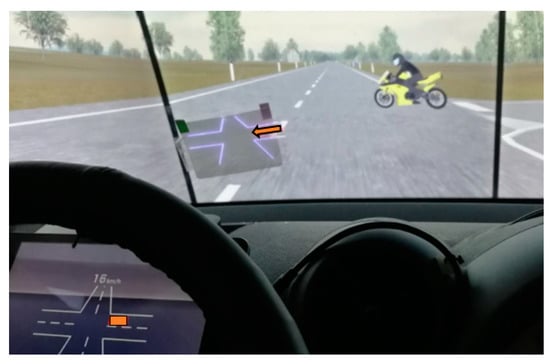
Figure 1.
Motorcycle warning [47]. Copyright © 2019 Federal Ministry Republic of Austria Climate Action, Environment, Energy, Mobility, Innovation and Technology. Illustration reprinted from the official project report featuring free access.
A tablet PC mounted in front of the steering wheel displayed a motorcycle icon when a motorcycle was recognized by the vehicle’s sensor system. In parallel to this, the motorcycle icon was displayed on a head-up display (HUD). The warnings system used data from a simulated vehicle-to-vehicle (V2V) communication. The warnings were triggered when a predefined time-to-collision threshold calculated from the current speed and direction was exceeded.
There were five consecutive trips on rural roads and five trips on urban roads. In each trip on rural roads, the trainees were confronted with three motorcycle encounters (Table 1) in one of the five typical accident configurations described in Table 2. At the end of the training, each motorcycle encounter scenario was practiced three times, with different orders of presentation to avoid learning artefacts. In each trip on urban roads, the trainees were confronted with three motorcycle encounters (Table 1) in one of the five typical accident configurations described in Table 3.
2.1.4. Control Group
The control group drove the same routes and number of trips on rural and urban roads as the other groups, but encountered no motorcycle traffic (Table 1). Their instruction was as similar to the conventional, part-task driver training (e.g., perform navigation, speed control) as possible. Participants from this group were not provided with objective feedback based on measured data.
2.2. Driving Simulator
The Automated Driving Simulator Graz (ADSG) of the Graz University of Technology is a fixed-base driving simulator based on a full vehicle. The visual system consists of LCD monitors with a 180-degree field of view. The engine, wind and rolling noise of the own vehicle, as well as other vehicles, are calculated, mixed and transmitted over four bass shakers, as well as the sound system of the vehicle. The vehicle controls (throttle, brake pedal, shifter and steering) are equipped with high-quality force-feedback actuators. The displays and controls (human–machine-interface) of the vehicle are configurable using Tablet PCs. The driving simulator was calibrated with experts in driving dynamics and validated with licensed drivers [48,49,50,51,52,53].
The implementation of motorcycle encounter scenarios in the driving simulator was calibrated and validated by experts in accident reconstruction and driving dynamics.
Pressure Sensitive Steering Wheel
The participants were instructed to press on the steering wheel as soon as possible whenever they observed a motorcycle. A pressure-sensitive sensor was used for data collection.
The time of the earliest possible motorcycle perception was logged as a binary signal for the subsequent evaluation.
2.3. Driving Scenarios
The trainees drove on urban and rural roads with speed limit markings. The speed limit on the urban road was set to 50 kph, and 100 kph on the rural road, with sectors of 80 kph marked by real road signs. The selection and preparation of the motorcycle encounter scenarios was based on an in-depth study of accidents from different Austrian and European databases, which is published in [34]. The scenarios identified by this study, including common accident types, conflict situations and parameters that contributed to the accident, were used for training and tests in the present study. An overview of the scenarios is presented in Table 2 and Table 3.
2.4. Experimental Procedure
All participants received a driving session of about 15 min for familiarization. The training trials were conducted alternately on urban and rural roads with high contrast. The driving training lasted for about 60 min per participant.
The post-test setting was identical for all groups, meaning that each group was confronted with five motorcycle encounters on rural roads (Table 2) and five on urban roads (Table 3). For urban roads, there was an additional test trip performed with low contrast between motorcycles and the environment, which made the motorcycles less detectable. None of the groups used the motorcycle warning, nor was feedback offered during these tests. Overall, the test consisted of three trips:
- One trip on the urban road with high contrast, with five motorcycle encounters per trip;
- One trip on the rural road with high contrast, with five motorcycle encounters per trip;
- One trip on the rural road with low contrast, with five motorcycle encounters per trip.
The order of presentation was counterbalanced, meaning that half of the trainees in each group started with urban and ended with rural road tests. The other half started with rural road tests and ended with urban road tests.
After the test, the participants received a questionnaire to evaluate the simulator training.
2.5. Participants
The study was conducted with 80 learner drivers aged between 15 and 27 years. At the time of participating in the study, the learner drivers had just completed their theoretical instruction in the driving school. Participation in the study was voluntary. The participants were informed about the study and signed an informed consent form. For underage participants, the parents were also informed about the study and signed the informed consent form. Each participant received an allowance of 40 Euros for participation. The groups were comparable in terms of average age and driving experience (Table 4).

Table 4.
Participant age and driving experience (SD: standard deviation).
2.6. Dependent Measures
A motorcycle perceptibility performance score was calculated for each scenario. The performance score was defined as the distance between the motorcycle and the car at the time of motorcycle-signalized detection, calculated as a percentage relative to the earliest possible detection distance. The earliest possible detection of a motorcycle was calculated as 100%. Later detection received relatively less than 100%. For each test on urban and rural roads, an average performance score was calculated for each trainee, as the mean score over five scenarios.
2.7. Data Analysis
The effects of training on the motorcycle perceptibility performance were analyzed as differences among the four training groups in the post-test. The data did not have a normal distribution. Thus, the non-parametric median test was used for statistical analysis and α was set to 0.05.
3. Results
3.1. Training Effects
Data are presented descriptively in Table 5. The results of the median test show significant differences between the training groups when driving on urban roads with high contrast (df = 3, χ2 = 11.30, p < 0.009).

Table 5.
Motorcycle perceptibility performance of the control and training groups in post-test (SD-standard deviation).
As illustrated in Figure 2, the number of learner drivers with a performance above the median (Med = 51.50) was greater in the groups that trained with variable priority and in the control group, as compared to the groups with equal priority and equal priority with warning.
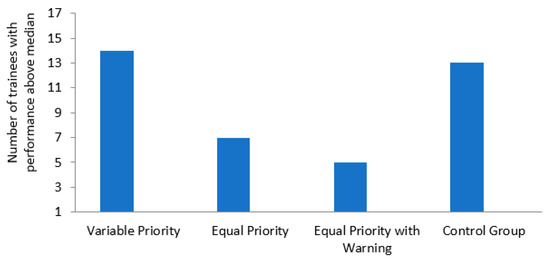
Figure 2.
Trainees’ performance in motorcycle detection on urban roads with high contrast.
Group differences in performance on rural roads with high contrast were not statistically significant (df = 3, χ2 = 2.80, p < 0.50).
The median test shows significant differences between the test groups on rural roads with low contrast (df = 3, χ2 = 8.40, p < 0.04). As shown in Figure 3, the largest number of trainees with a performance above the median (Med = 51.54) is found in the variable priority group.
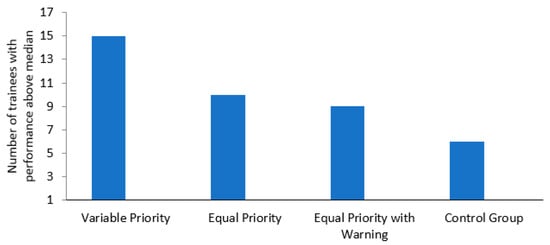
Figure 3.
Trainee performance in motorcycle detection on rural roads with low contrast.
3.2. Subjective Assessment of the Training
The results of the post-test assessment show that most of the learner drivers rated the training as useful (Figure 4).
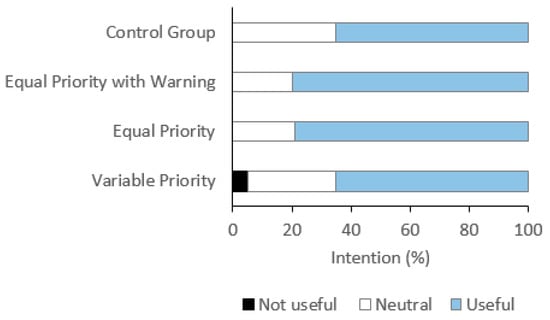
Figure 4.
Subjective assessment of training.
As illustrated in Figure 5, the intention to repeat the training in future, if given the possibility, was reported by most of the learner drivers (e.g., for sure or perhaps). Only a few trainees stated that they would not continue the training or were not sure about doing so. Most of the learner drivers would recommend the driving simulator training to other learner drivers (Figure 6).
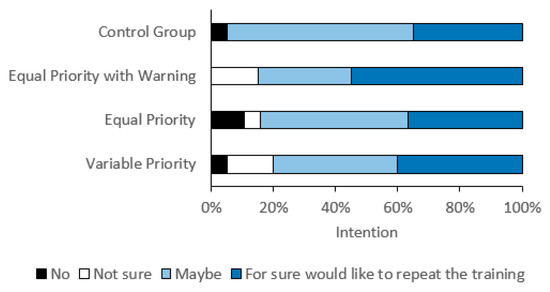
Figure 5.
Trainees’ reported intention to repeat the training.
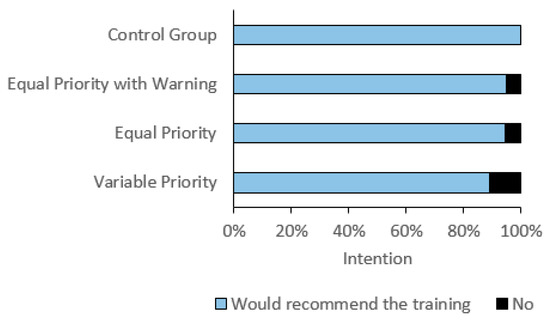
Figure 6.
Trainees’ reported intention to recommend the training to somebody else.
4. Discussion
The protection of motorcycle drivers as vulnerable road users became critical due to the high accident frequency [2,3] and the opportunities created by improvements in active and passive vehicle safety [1]. This research aimed to develop preventive training programs for learner drivers and to investigate the role of simulator-based training in the perceptibility of motorcycles. Knowing that about half of motorcycle accidents involving cars were caused by the car drivers [8,9,10,11], in this study, motorcycle detection training methods were developed and implemented in a driving simulator. These training methods were assessed with 80 learner drivers assigned to a variable priority group (N = 20), an equal priority group (N = 20), an equal priority with warning (N = 20) and a control group (N = 20). To assess the training effects on the motorcycle perceptibility performance, post-tests were performed on urban and rural roads, confronting the learner drivers with typical accident scenarios.
4.1. Training Effects on the Perceptibility of Motorcycles on Urban Roads with High Contrast
As expected, the variable priority training resulted in the best motorcycle perceptibility on urban roads with high contrast, demonstrating that this group of learner drivers benefited from objective performance feedback that highlighted performance benefits and decrements depending on the priority given to subtasks. According to Gopher et al. [43], this training effect indicates that variable priority training results in “response strategies that can be employed flexibly to meet task demands” [43] (p. 147). A point of interest is that the use of a motorcycle warning system resulted in the lowest performance in the group that trained with equal priority and warning in post-test when they could not use the warning anymore. The reason for this may be that the learner drivers in this group developed an over-reliance on the warning. A slightly better performance was observed in the group that trained with equal priority testing that did not use a warning system. The fact that the control group performed so well on urban roads with high contrast is difficult to explain. The control group trained without traffic and, thus, these trainees could concentrate all their resources on practicing vehicle control and learning the road layout.
4.2. Motorcycle Perceptibility on Rural Roads with High Contrast
The descriptive data analysis indicates that the variable priority group performed slightly better than the other groups on rural roads with good contrast, but the results did not reach statistical significance. Thus, for the typical accident scenarios on rural roads, the training method did not make a significant difference to the perceptibility of motorcycles. Probably, these motorcycle encounter scenarios on rural roads were more challenging.
4.3. Motorcycle Perceptibility on Rural Roads with Low Contrast
On rural roads with low contrast, the variable priority training resulted in significantly better motorcycle perceptibility performance as compared to the other training methods and the control group. This was the post-test condition with the highest level of difficulty because of the low contrast, and also because all groups only trained in conditions of high contrast between the motorcycle and the environment. These results confirm the results of Gopher et al. [43], indicating that the VP training group benefited from the objective performance feedback and developed strategies to flexibly meet the task demands. Training with equal priority resulted in similar performance levels in the groups equal priority and equal priority with warning. Interestingly, the training with a motorcycle warning system did not result in better performance in post-test when the warning was not available anymore. As expected, the control group showed the lowest level of performance, meaning that they detected motorcycles later than the participants from other groups, when the separation time was shorter.
4.4. Overall Discussion
These results show that VP training in the driving simulator has a positive effect on the early perceptibility of motorcycles. Therefore, the number and severity of collisions for typical car–motorcycle encounters [34] could be reduced through the early detection of motorcycles by the car driver. Thus, the benefit of task-sharing skills developed by VP training seems to be more powerful than practicing typical car–motorcycle encounters when the learner drivers try to do their best (equal priority group) or when they try to do their best and have experience with a motorcycle warning system (equal priority and warning group). Since perceptibility issues are considered to be responsible for a major part of severe motorcycle accidents, simulator-based VP training has the potential to increase motorcycle safety.
Beyond the objective benefits of simulator training, the results also show that the learner drivers appreciated the opportunity to practice in the simulator. Most of the trainees from each group considered the simulator training useful and would recommend it to somebody else. A number of trainees reported that they would continue to train if they had the possibility to do so. As noted in previous research, the trainees appreciated the benefits of simulators for practicing realistic critical situations that would be impracticable or unsafe to create and practice in reality [39,40,41].
Training for improving hazard perception in learner drivers was recommended by previous studies [20,21]. Positive effects have been reported for different types of training, such as video material [23], online hazard perception training [26], proactive listening to training commentaries [25], or driving simulator training [27]. However, to our knowledge, this is the first study implementing and assessing the VP paradigm in a driving simulator with the purpose of improving the motorcycle detection performance of learner drivers.
5. Conclusions
The training had different effects on the performance of learner drivers in the driving simulator depending on the training method used. The variable priority training significantly improved performance for both the early detection of motorcycles on urban roads and on rural roads with low contrast. This compared to the training methods equal priority and equal priority with warning. These results partly confirm the results of Gopher et al. [43,44]. The one-hour training program in the driving simulator in the present study had a positive effect. The presented method is a useful tool to reduce the number of accidents and accident operations and thus, the social and economic costs. Sensitizing the learner drivers to recognize motorcyclists could help car drivers to avoid critical situations that lead to accidents. The present study shows how the human factor can be considered for accident prevention in the whole system, including the road, the vehicle and the human. The recognizability of motorcyclists depending on the road environment has to be trained in order to sustainably reduce the number of motorcycle accidents. In the future, the duration of simulator-based driver training could be extended, since many of the learner drivers could imagine having the training period extended. Most learner drivers reported that the simulator training was useful, because it provided an opportunity to practice with dangerous scenarios. Such safety-critical motorcycle encounters can only be practiced in a driving simulator. The learner drivers are thus given the opportunity to familiarize themselves with motorcycle-related hazards. Training in the simulator, however, cannot replace practical training in the vehicle, on the road. However, the simulator training can help to recognize dangerous situations between cars and motorcycles at an early stage, and thus to react in a way that avoids accidents.
Author Contributions
Conceptualization, A.E. and I.V.K.; methodology, M.K. and I.V.K.; validation, M.K., I.V.K.; formal analysis, A.E.; investigation; M.K. and I.V.K.; resources, A.E., M.K. and I.V.K.; data curation, A.E., I.V.K.; writing—original draft preparation, I.V.K., M.K. and A.E.; writing—review and editing, I.V.K., M.K. and A.E.; visualization, M.K. and I.V.K.; supervision, I.V.K.; project administration, A.E.; funding acquisition, M.K., A.E. and I.V.K. All authors have read and agreed to the published version of the manuscript.
Funding
This research was funded by the Austrian Federal Ministry of Transportation, Innovation and Technology funding program: Österreichischer Verkehrssicherheitsfond. The publication is funded by the Open Access Funding by the Graz University of Technology.
Institutional Review Board Statement
The study was conducted in accordance with the Declaration of Helsinki.
Informed Consent Statement
Informed consent was obtained from all subjects involved in the study.
Data Availability Statement
Not applicable.
Acknowledgments
This article is based on the official project report of the funding Organization BMK and can be found at: https://www.bmk.gv.at/dam/jcr:5111b52f-ab9b-488a-8c61-c34ce6b6489d/70_IMPMOD_ua.pdf (accessed on 1 April 2022).
Conflicts of Interest
The authors declare no conflict of interest. The funding source had no involvement in the conduct of the research, in the preparation of the article nor in the decision to submit the article for publication. The funders had no role in the design of the study; in the collection, analyses, or interpretation of data; in the writing of the manuscript, or in the decision to publish the results.
References
- European Commission. Traffic Safety Basic Facts on Motorcycles & Mopeds; European Commission: Brussels, Belgium, 2017. [Google Scholar]
- European Commission. 2017 Road Safety Statistics: What is Behind the Figures? European Commission: Brussels, Belgium, 2018; p. 5. [Google Scholar]
- Statistik Austria. Straßenverkehrsunfälle 2014, 1. Bis 4. Quartal Jahresergebnisse; Statistik Austria: Wien, Austria, 2015.
- Yasin, Y.J.; Grivna, M.; Abu-Zidan, F.M. Motorized 2–3 wheelers death rates over a decade: A global study. World J. Emerg. Surg. 2022, 17, 7. [Google Scholar] [CrossRef] [PubMed]
- Ijaz, M.; Lan, L.; Usman, S.M.; Zahid, M.; Jamal, A. Investigation of factors influencing motorcyclist injury severity using random parameters logit model with heterogeneity in means and variances. Int. J. Crashworthiness 2021. [Google Scholar] [CrossRef]
- Martins, R.S.; Saqib, S.U.; Raja, M.H.R.; Gillani, M.; Zafar, H. Collision versus loss-of-control motorcycle accidents: Comparing injuries and outcomes. Traffic Inj. Prev. 2022, 1–5. [Google Scholar] [CrossRef] [PubMed]
- Abrari Vajari, M.; Aghabayk, K.; Sadeghian, M.; Shiwakoti, N. A multinomial logit model of motorcycle crash severity at Australian intersections. J. Saf. Res. 2020, 73, 17–24. [Google Scholar] [CrossRef] [PubMed]
- Bartl, G.; Hager, B.; Urbanek, K. Unfallursachenanalyse von Zweiradfahrern; Kuratorium für Verkehrssicherheit (KfV): Wien, Austria, 2009. [Google Scholar]
- Walter, E.; Cavegn, M.; Ewert, U.; Scaramuzza, G.; Achermann-Stürmer, Y.; Niemann, S.; Uhr, A. Motorradverkehr; Beratungsstelle für Unfallverhütung: Bern, Switzerland, 2014. [Google Scholar]
- Unger, T.; Widmann, C.; Pschenitza, M. Unfälle mit Motorrädern, Neue Aspekte der Motorradsicherheit! ADAC: Berlin, Germany, 2013. [Google Scholar]
- Widmann, C.; Unger, T.; Pschenitza, M. Unfälle mit Motorrädern—Neue Aspekte der Motorradsicherheit! ADAC: Berlin, Germany, 2015; p. 33. [Google Scholar]
- Ker, K.; Roberts, I.; Collier, T.; Beyer, F.; Bunn, F.; Frost, C. Post-licence driver education for the prevention of road traffic crashes: A systematic review of randomised controlled trials. Accid. Anal. Prev. 2005, 37, 305–313. [Google Scholar] [CrossRef] [PubMed]
- Christie, R. The Effectiveness of Driver Training as a Road Safety Measure: A Review of the Literature; The National Academies of Sciences: Washington, DC, USA, 2001. [Google Scholar]
- Isler, R.B.; Starkey, N.J.; Sheppard, P. Effects of higher-order driving skill training on young, inexperienced drivers’ on-road driving performance. Accid. Anal. Prev. 2011, 43, 1818–1827. [Google Scholar] [CrossRef]
- Mayhew, D.R.; Simpson, H.M. The safety value of driver education and training. Inj. Prev. 2002, 8, ii3–ii8. [Google Scholar] [CrossRef]
- Schneider, C.A.; Hajiseyedjavadi, F.; Tainter, F.; Michael Knodler, J.; Zhang, J.; Romoser, M.; Samuel, S.; Fisher, D. Measuring the Applicability of Intersection-Based Older Driver Training Programs. Transp. Res. Rec. 2020, 2674, 878–886. [Google Scholar] [CrossRef]
- Haworth, N.; Mulvihill, C.; Symmons, M. Hazard Perception and Responding by Motorcyclists: Background and Literature Review; Monash University Accident Research Centre: Melbourne, Australia, 2005. [Google Scholar]
- Damm, L.; Nachtergaële, C.; Meskali, M.; Berthelon, C. The evaluation of traditional and early driver training with simulated accident scenarios. Hum. Factors 2011, 53, 323–337. [Google Scholar] [CrossRef]
- Horswill, M.S. Improving Fitness to Drive: The Case for Hazard Perception Training. Aust. Psychol. 2016, 51, 173–181. [Google Scholar] [CrossRef]
- Wetton, M.A.; Horswill, M.S.; Hatherly, C.; Wood, J.M.; Pachana, N.A.; Anstey, K.J. The development and validation of two complementary measures of drivers’ hazard perception ability. Accid. Anal. Prev. 2010, 42, 1232–1239. [Google Scholar] [CrossRef] [PubMed]
- Wetton, M.A.; Hill, A.; Horswill, M.S. Are what happens next exercises and self-generated commentaries useful additions to hazard perception training for novice drivers? Accid. Anal. Prev. 2013, 54, 57–66. [Google Scholar] [CrossRef] [PubMed]
- Rosenbloom, T.; Perlman, A.; Pereg, A. Hazard perception of motorcyclists and car drivers. Accid. Anal. Prev. 2011, 43, 601–604. [Google Scholar] [CrossRef] [PubMed]
- Horswill, M.S.; Taylor, K.; Newnam, S.; Wetton, M.; Hill, A. Even highly experienced drivers benefit from a brief hazard perception training intervention. Accid. Anal. Prev. 2013, 52, 100–110. [Google Scholar] [CrossRef] [PubMed]
- Ka, E.; Kim, D.G.; Hong, J.; Lee, C. Implementing Surrogate Safety Measures in Driving Simulator and Evaluating the Safety Effects of Simulator-Based Training on Risky Driving Behaviors. J. Adv. Transp. 2020, 2020, 7525721. [Google Scholar] [CrossRef]
- Castro, C.; Ventsislavova, P.; Peña-Suarez, E.; Gugliotta, A.; Garcia-Fernandez, P.; Eisman, E.; Crundall, D. Proactive Listening to a Training Commentary improves hazard prediction. Saf. Sci. 2016, 82, 144–154. [Google Scholar] [CrossRef]
- Horswill, M.S.; Hill, A.; Silapurem, L.; Watson, M.O. A thousand years of crash experience in three hours: An online hazard perception training course for drivers. Accid. Anal. Prev. 2021, 152, 105969. [Google Scholar] [CrossRef]
- Crundall, D.; Andrews, B.; Van Loon, E.; Chapman, P. Commentary training improves responsiveness to hazards in a driving simulator. Accid. Anal. Prev. 2010, 42, 2117–2124. [Google Scholar] [CrossRef]
- Castro, C.; Muela, I.; Doncel, P.; García-Fernández, P. Hazard Perception and Prediction test for walking, riding a bike and driving a car: “Understanding of the global traffic situation”. PLoS ONE 2020, 15, e0238605. [Google Scholar] [CrossRef]
- Borowsky, A.; Shinar, D.; Oron-Gilad, T. Age, skill, and hazard perception in driving. Accid. Anal. Prev. 2010, 42, 1240–1249. [Google Scholar] [CrossRef]
- ÖAMTC Motorradunfälle—Unfallgeschehen und Unfallursachen auf Ausgewählten, “Klassischen” Motorradstrecken; ÖAMTC Unfallforschung: Vienna, Austria, 2016; p. 56.
- BMK. Österreichische Verkehrssicherheitsstrategie 2021–2030; BMK: Wien, Austria, 2021. [Google Scholar]
- Statistik Austria. Verletzte und Getötete 2012 bis 2015 nach Verkehrsarten; Statistik Austria: Wien, Austria, 2015.
- Kramlich, T. Noch immer gefaehrliche Begegnungen. Die häufigsten Gefahrensituationen für Motorradfahrer und die resultierenden Verletzungen. In Proceedings of the Sicherheit Umwelt Zukunft IV. Tagungsband der 4. Internationalen Motorradkonferenz 2002; Institut für Zweiradsicherheit GmbH: Essen, Germany, 2002; pp. 55–84. [Google Scholar]
- Kraut, M.; Eichberger, A.; Koglbauer, I.; Lex, C. Analyse relevanter Szenarien und Fahraufgaben zur Verringerung schwerer Pkw-Motorrad-Kollisionen. Z. Verk. 2020, 66, 257–269. [Google Scholar]
- MAIDS. Depth Investigation of Motorcycle Accidents; MAIDS: Brussels, Belgium, 2009. [Google Scholar]
- Winterthur Versicherung. DEKRA Auto und Motorrad: Auf Kollisionskurs? Motorradunfälle Vermeiden; Winterthur Versicherung: Winterthu, Switzerland; DEKRA AG: Stuttgart, Germany, 2004. [Google Scholar]
- Wells, S.; Mullin, B.; Norton, R.; Langley, J.; Connor, J.; Lay-Yee, R.; Jackson, R. Motorcycle rider conspicuity and crash related injury: Case-control study. Br. Med. J. 2004, 328, 857. [Google Scholar] [CrossRef] [PubMed]
- Walter, E.; Cavegn, M.; Scaramuzza, G.; Niemann, S.; Bächli-Biétry, J. Motorradverkehr; Beratungsstelle für Unfallverhütung: Bern, Switzerland, 2009. [Google Scholar]
- Koglbauer, I. Simulator Training Improves the Estimation of Collision Parameters and the Performance of Student Pilots. Procedia Soc. Behav. Sci. 2015, 209, 261–267. [Google Scholar] [CrossRef][Green Version]
- Koglbauer, I. Training for Prediction and Management of Complex and Dynamic Flight Situations. Procedia Soc. Behav. Sci. 2015, 209, 268–276. [Google Scholar] [CrossRef]
- Koglbauer, I.; Braunstingl, R. Ab initio pilot training for traffic separation and visual airport procedures in a naturalistic flight simulation environment. Transp. Res. Part F Traffic Psychol. Behav. 2018, 58, 23. [Google Scholar] [CrossRef]
- Wickens, C.D.; Hutchins, S.; Carolan, T.; Cumming, J. Effectiveness of part-task training and increasing-difficulty training strategies: A meta-analysis approach. Hum. Factors 2013, 55, 461–470. [Google Scholar] [CrossRef] [PubMed]
- Gopher, D.; Weil, M.; Siegel, D. Practice under changing priorities: An approach to the training of complex skills. Acta Psychol. 1989, 71, 147–177. [Google Scholar] [CrossRef]
- Gopher, D.; Weil, M.; Bareket, T. Transfer of skill from a computer game trainer to flight. Hum. Factors 1994, 36, 387–405. [Google Scholar] [CrossRef]
- Zahabi, M.; Nasr, V.; Abdul Razak, A.M.; McCanless, L.; Maredia, A.; Patranella, B.; Wozniak, D.; Shahini, F. Effect of variable priority training on police officer driving performance and workload. Ergonomics 2022. [Google Scholar] [CrossRef]
- Cassavaugh, N.D.; Kramer, A.F. Transfer of computer-based training to simulated driving in older adults. Appl. Ergon. 2009, 40, 943–952. [Google Scholar] [CrossRef]
- Eichberger, A.; Koglbauer, I.; Kraut, M. Improved Perception of Motorcycles; Forschungsarbeiten des Österreichischen Verkehrssicherheitsfonds: Graz, Austria, 2019; Available online: https://www.bmk.gv.at/dam/jcr:5111b52f-ab9b-488a-8c61-c34ce6b6489d/70_IMPMOD_ua.pdf (accessed on 27 April 2014).
- Koglbauer, I.V.; Eichberger, A.; Lex, C.; Bliem, N.; Sternat, A.S.; Holzinger, J.; Schinko, C.; Battel, M. Bewertung von Fahrerassistenzsystemen von nicht professionellen Fahrerinnen und Fahrern im Realversuch. In Humanwissenschaftliche Beiträge zur Verkehrssicherheit und Ökologie des Verkehrs, Mehr Sicheres Verhalten im Strassenverkehr; INFAR-Institut für Nachschulung: Salzburg, Austria, 2015; pp. 86–102. ISBN 978-3-200-04406-7. [Google Scholar]
- Koglbauer, I.; Holzinger, J.; Eichberger, A.; Lex, C. Drivers’ interaction with adaptive cruise control on dry and snowy roads with various tire-road grip potentials. J. Adv. Transp. 2017, 2017, 5496837. [Google Scholar] [CrossRef]
- Arefnezhad, S.; Eichberger, A.; Koglbauer, I.V. Effects of Automation and Fatigue on Drivers from Various Age Groups. Safety 2022, 8, 30. [Google Scholar] [CrossRef]
- Arefnezhad, S.; Hamet, J.; Eichberger, A.; Frühwirth, M.; Ischebeck, A.; Koglbauer, I.V.; Moser, M.; Yousefi, A. Driver drowsiness estimation using EEG signals with a dynamical encoder–decoder modeling framework. Sci. Rep. 2022, 12, 2650. [Google Scholar] [CrossRef] [PubMed]
- Arefnezhad, S.; Eichberger, A.; Frühwirth, M.; Kaufmann, C.; Moser, M.; Koglbauer, I.V. Driver Monitoring of Automated Vehicles by Classification of Driver Drowsiness Using a Deep Convolutional Neural Network Trained by Scalograms of ECG Signals. Energies 2022, 15, 480. [Google Scholar] [CrossRef]
- Schinko, C.; Peer, M.; Hammer, D.; Pirstinger, M.; Lex, C.; Koglbauer, I.V.; Eichberger, A.; Holzinger, J.; Eggeling, E.; Fellner, W.-D.; et al. Building a Driving Simulator with Parallax Barrier Displays. In Proceedings of the 11th Joint Conference on Computer Vision, Imaging and Computer Graphics Theory and Applications (VISIGRAPP 2016), Rome, Italy, 27–29 February 2016; p. 283. [Google Scholar]
Publisher’s Note: MDPI stays neutral with regard to jurisdictional claims in published maps and institutional affiliations. |
© 2022 by the authors. Licensee MDPI, Basel, Switzerland. This article is an open access article distributed under the terms and conditions of the Creative Commons Attribution (CC BY) license (https://creativecommons.org/licenses/by/4.0/).

